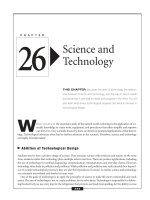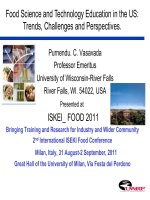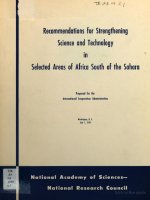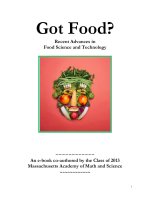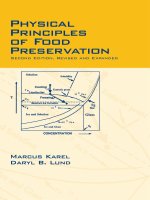English for food science and technology
Bạn đang xem bản rút gọn của tài liệu. Xem và tải ngay bản đầy đủ của tài liệu tại đây (2.45 MB, 85 trang )
English for Food Science and
Technology
Le Van Diep, PhD
Section of Food Technology, Faculty of Chemistry
0915.232.859
Objective
The purpose of this course is to provide students with
the basic knowledge of food science and technology in
English, and to improve speaking, reading, writing,
translating skills in this field.
2
Teaching method
This subject include: 3 units (30/15)
3
Contents
Section One: Introduction and Background (13)
Chapter 1. Concepts of food science & technology (1)
Chapter 2. Quality factors in foods (3)
Chapter 3. Unit operations in food processing (6)
Chapter 4. Food deterioration (3)
Section Two: Preservation (17)
Chapter 5. Heat (2)
Chapter 6. Cold (2)
Chapter 7. Drying and Dehydration (3)
Chapter 8. Fermentation, Microorganisms, and Biotechnology
Chapter 9. Chemical (2)
Chapter 10. Packaging (2)
4
Contents
Section Three: Foods and Food products (8) - Seminar
Chapter 11. Milk (2)
Chapter 12. Beverages (3)
Chapter 13. Fruits and Vegetables (3)
Section Four: Related Issues (7)
Chapter 13. Food safety (4)
Chater 14. Regulation and Labeling (3)
5
Section One
Introduction and Background
6
Chapter 1
Concepts of food science & technology
7
What is food science & technology?
Science through observation/ experimentation
understand, or to understand better (knowledge).
When science becomes knowledge?
Science becomes knowledge by publication of research
results.
Food science is the study of the physical, biological, and
chemical makeup of food/ to better understand food
processes.
8
What is food science & technology?
9
What Is Food Science & Technology?
Technology: the methods for using scientific discoveries
for practical purposes, esp. in industry.
Food technology is the application of food science to
the selection, preservation, processing, packaging,
distribution, and use of safe food.
Food science Basic science
Food technology Apply science
10
What Is Food Science & Technology?
The Institute of Food Technologists defines food science
as "the discipline in which the engineering, biological,
and physical sciences are used to study the nature of
foods, the causes of deterioration, the principles
underlying food processing, and the improvement of
foods for the consuming public".
11
Become a food scientist
Food scientists are involved in all aspects of this
process, from the point of animal and crop production to
the time of food consumption. This includes developing
new and improved foods, analyzing food for its
nutritional value and safety, and researching better ways
to preserve food.
12
Become a food technologist
Food technologists develop and improve existing food
products and set standards for producing, packaging and
marketing food. They also undertake basic and applied
research into aspects of food preservation, food quality
and shelf-life.
13
Chapter 2
Quality factors in foods
(3h)
14
2.1. Concept
Quality of food product involves maintenance or
improvement of the key attributes of the productincluding color, flavor, texture, safety, healthful, shelf
life and convenience.
To maintain quality, it is importance to control
microbiological spoilage, enzymatic degradation, and
chemical degradation.
These components of quality depend upon the
composition of the food, processing methods, packaging,
and storage.
15
2.2. Appearance factors
Appearance is important to the consumers how food
should look!
Color attributes
Geometric attributes (size and shape)
16
2.2.1. Color
Of these two, color is by far the most important.
Comsumers expect meat to be red, apple juice to be light
yellow and clear, orange juice to be orange, and so on.
17
2.2.1. Color
Food color meansurements provide an objective index of
food quality.
Color is an indication of ripeness or spoilage.
Changes in expected colors can also indicate problems
with the processing or packaging.
But with the development of biotechnology
everything change!
18
2.2.1. Color
Source of color in food:
Naturally occurring pigments (anthocyanins)
Enzymatic
Nonenzymatic
reaction
(Maillard
reactions:
browing reaction)
What is the Maillard reactions? The conditions
of this reaction?
19
2.2.1. Color - Measuring
In order to maintain quality, the color of food products must be
measured and standardized.
Colorimeters or spectrophotometers can be used for
color measurent (juice or colored extract).
The color of liquid or solid foods can be measured by
comparing their reflected color
(standardized) color tiles or chips.
to
defined
20
2.2.2. Size and Shape
Depending on the product, comsumer expect food to
have certain sizes and shapes.
Size and shape are easyly measured. Fruits and
vegetables are graded based on their size and shape, and
this is done by the openings they will pass through
during grading.
21
2.2.3. Textural factors
The textural of food refers to the qualities felt with the
fingers, the tongue, or the teeth.
Textures in food vary widely, but any departure from
what the comsumer expects is a quality defect.
Texture is a mechanical behavior of foods measured by
sensory or physical means.
22
2.2.4. Flavor factors
Food flavor includes taste sensations perceived by the
tongue – sweet, salty, sour, and bitter – and smells
perceived by the nose.
Often the term flavor and smell
(aroma) are used interchangeably.
Taste areas of the tongue
23
2.2.4. Flavor factors
Food flavor and aroma are difficult to measure and
difficult to get people to agree on.
A part of food science called sensory science is
dedicated to finding ways to help humans accurately
describle the flavors and other sensory properties of their
food.
Food flavor is a combination of taste and smell, and it is
very subjective and difficult to measure.
People deffer in their ability to detect tastes and odors.
24
2.2.4. Flavor factors
Taste panels
For comsumer quality acceptance, the best method of
measuring taste is to have people taste the products.
Taste panels may be a group of professionals, or they
may be a group of customers.
Typically taste panels are in separate booths so that they
cannot influence each other.
Food samples are coded with letters and numbers, and
tasters are given an evaluation form to complete as they
taste the product and evaluate it.
25
